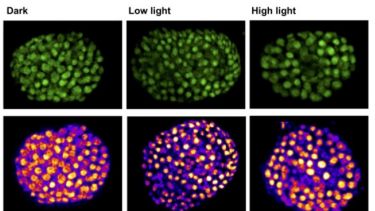Regulation of photosynthesis
We study the regulation of light harvesting and electron transfer in photosynthesis using spectroscopy and membrane-level imaging approaches

The chloroplast thylakoid membrane is the site for the initial steps of photosynthesis that convert solar energy into chemical energy, ultimately powering almost all life on earth. The heterogeneous distribution of protein complexes within the membrane gives rise to an intricate three-dimensional structure that is nonetheless extremely dynamic on a timescale of seconds to minutes. These dynamics form the basis for the regulation of photosynthesis, and therefore the adaptability of plants to different environments. In photosynthesis, light-harvesting complexes (LHCs) capture solar energy and feed it to the downstream molecular machinery. However, when light absorption exceeds the capacity for utilization, the excess energy can cause damage. Thus, LHCs have evolved a feedback loop that triggers photoprotective energy dissipation. The critical importance of photoprotection for plant fitness has been demonstrated, as well as its impact on crop yields. However, the mechanisms of photoprotection ― from fast chemical reactions of molecules to slow conformational changes of proteins ― have not yet been resolved.
We use a multi-faceted approach that includes atomic force, electron and fluorescence microscopies in combination with biochemistry and spectroscopy to probe the mechanistic details that underpin photosynthetic regulation.

Experience Sheffield for yourself
The best way to find out what studying at Sheffield is like is to visit us. You'll get a feel for the atmosphere, the people, the campus and the city.
